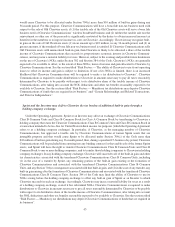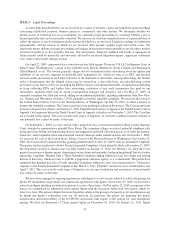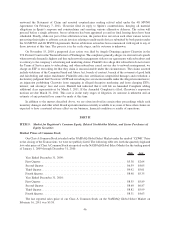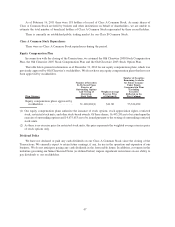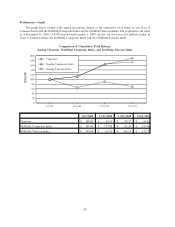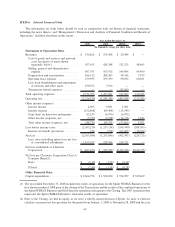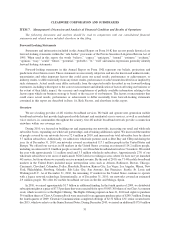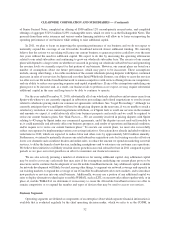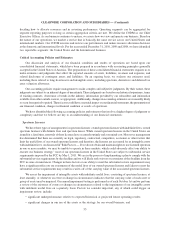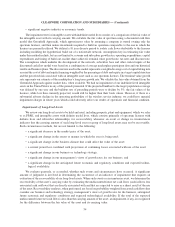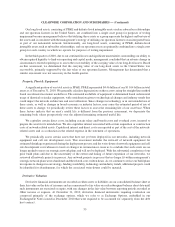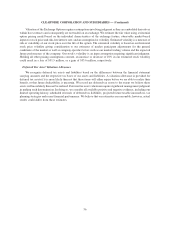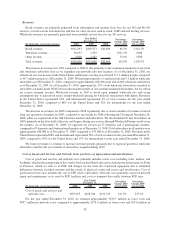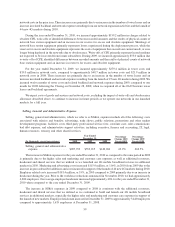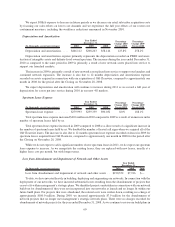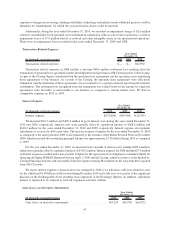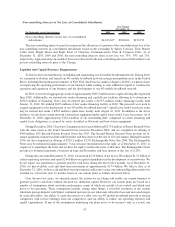Clearwire 2010 Annual Report Download - page 58
Download and view the complete annual report
Please find page 58 of the 2010 Clearwire annual report below. You can navigate through the pages in the report by either clicking on the pages listed below, or by using the keyword search tool below to find specific information within the annual report.deciding how to allocate resources and in assessing performance. Operating segments can be aggregated for
segment reporting purposes so long as certain aggregation criteria are met. We define the CODM as our Chief
Executive Officer. As our business continues to mature, we assess how we view and operate our business. Based on
the nature of our operations, we market a service that is basically the same service across our United States and
international markets. Our CODM assesses and reviews our performance and makes resource allocation decisions
at the domestic and international levels. For the years ended December 31, 2010, 2009 and 2008, we have identified
two reportable segments: the United States and the International business.
Critical Accounting Policies and Estimates
Our discussion and analysis of our financial condition and results of operations are based upon our
consolidated financial statements, which have been prepared in accordance with accounting principles generally
accepted in the United States of America. The preparation of these consolidated financial statements requires us to
make estimates and judgments that affect the reported amounts of assets, liabilities, revenues and expenses, and
related disclosure of contingent assets and liabilities. On an ongoing basis, we evaluate our estimates used,
including those related to long-lived assets and intangible assets, including spectrum, derivatives and deferred tax
asset valuation allowance.
Our accounting policies require management to make complex and subjective judgments. By their nature, these
judgments are subject to an inherent degree of uncertainty. These judgments are based on our historical experience, terms
of existing contracts, observance of trends in the industry, information provided by our subscribers and information
available from other outside sources, as appropriate. Additionally, changes in accounting estimates are reasonably likely
to occur from period to period. These factors could have a material impact on our financial statements, the presentation of
our financial condition, changes in financial condition or results of operations.
We have identified the following accounting policies and estimates that involve a higher degree of judgment or
complexity and that we believe are key to an understanding of our financial statements:
Spectrum Licenses
We have three types of arrangements for spectrum licenses: owned spectrum licenses with indefinite lives, owned
spectrum licenses with definite lives and spectrum leases. While owned spectrum licenses in the United States are
issued for a fixed time, renewals of these licenses have occurred routinely and at nominal cost. Moreover, management
has determined that there are currently no legal, regulatory, contractual, competitive, economic or other factors that
limit the useful lives of our owned spectrum licenses and therefore, the licenses are accounted for as intangible assets
with indefinite lives. As discussed in “Risk Factors — If we do not obtain and maintain rights to use licensed spectrum
in one or more markets, we may be unable to operate in these markets, which could adversely affect our ability to
execute our business strategy,” most of our spectrum licenses in the United States are subject to substantial service
requirements imposed by the FCC by May 1, 2011. We are in the process of implementing a plan to comply with the
substantial service requirements by the deadline and we will likely seek waivers or extensions of the deadline from the
FCC in some circumstances. Changes in these factors or our ability to meet the substantial service requirements may
have a significant effect on our assessment of the useful lives of our owned spectrum licenses and failure to meet the
substantial service requirements may result in a write-off of the carrying value of the associated spectrum licenses.
We assess the impairment of intangible assets with indefinite useful lives, consisting of spectrum licenses, at
least annually, or whenever an event or change in circumstances indicates that the carrying value of such asset or
group of assets may be impaired. Our annual impairment testing is performed as of each October 1st and we perform
a review of the existence of events or changes in circumstances related to the impairment of our intangible assets
with indefinite useful lives on a quarterly basis. Factors we consider important, any of which could trigger an
impairment review, include:
• significant underperformance relative to expected historical or projected future operating results;
• significant changes in our use of the assets or the strategy for our overall business; and
53
CLEARWIRE CORPORATION AND SUBSIDIARIES — (Continued)


